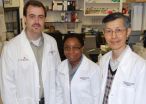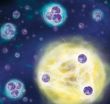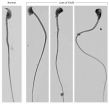(Press-News.org) In a major scientific review of research on e-cigarettes, UC San Francisco scientists found that industry claims about the devices are unsupported by the evidence to date, including claims that e-cigarettes help smokers quit.
The review marks the first comprehensive assessment of peer-reviewed published research into the relatively new phenomenon of electronic cigarettes.
The devices, which are rapidly gaining a foothold in popular culture particularly among youth, are marketed as a healthier alternative to tobacco smoking, as an effective tool to stop smoking, and as a way to circumvent smoke-free laws by allowing users to "smoke anywhere." Often the ads stress that e-cigarettes produce only "harmless water vapor."
But in their analysis of the marketing, health and behavioral effects of the products, which are unregulated, the UCSF scientists found that e-cigarette use is associated with significantly lower odds of quitting cigarettes. They also found that while the data are still limited, e-cigarette emissions "are not merely 'harmless water vapor,' as is frequently claimed, and can be a source of indoor air pollution."
The long-term biological effects of use are still unknown, the authors said.
In tackling the question of whether e-cigarette use is helping or harming the nation's tobacco control efforts, the authors analyzed 84 research studies on e-cigarettes and other related scientific materials.
They concluded that e-cigarettes should be prohibited wherever tobacco cigarettes are prohibited and should be subject to the same marketing restrictions as conventional cigarettes.
The paper is published May 12, 2014 in the American Heart Association's journal Circulation. http://circ.ahajournals.org/content/129/19/1972.full
E-cigarettes deliver a nicotine-containing aerosol popularly called "vapor" to users by heating a solution commonly consisting of glycerin, nicotine and flavoring agents. E-liquids are flavored, including tobacco, menthol, coffee, candy, fruit and alcohol flavorings.
Despite many unanswered questions about e-cigarette safety, the impact on public health, and whether the products are effective at reducing tobacco smoking, e-cigarettes have swiftly penetrated the marketplace in the United States and abroad in both awareness and use. Sold by the major multinational tobacco and other companies, the devices are aggressively marketed in print, television and the Internet with messages similar to cigarette marketing in the 1950s and 1960s, even in the U.S. and other countries that have long banned advertising for cigarettes and other tobacco products.
In one indication of the swiftness by which the devices have been embraced, in the U.S. youth "ever use" of the devices rose from 3.3 percent in 2011 to 6.8 percent the following year; in Korea, youth "ever use" of e-cigarettes rose from .5 percent in 2008 to 9.4 percent in 2011. "Ever use" means whether one has smoked the product even just once.
Furthermore, most adults and youths who use e-cigarettes are engaging in "dual use" – smoking both e-cigarettes and conventional cigarettes.
While most youth using e-cigarettes are dual users, up to a third of adolescent e-cigarette users have never smoked a conventional cigarette, indicating that some youth are starting use of the addictive drug nicotine with e-cigarettes.
The report also tackles secondhand exposure.
"E-cigarettes do not burn or smolder the way conventional cigarettes do, so they do not emit side-stream smoke; however, bystanders are exposed to aerosol exhaled by the user," said the authors. Toxins and nicotine have been measured in that aerosol, such as formaldehyde, acetaldehyde, acetic acid and other toxins emitted into the air, though at lower levels compared to conventional cigarette emissions.
One study of e-cigarettes was conducted to resemble a smoky bar: the researchers found that markers of nicotine in nonsmokers who sat nearby was similar for both cigarette smoke and e-cigarette aerosol exposure. Short-term exposure studies of e-cigarette use show a negative impact on lung function and bystanders absorb nicotine from passive exposure to e-cigarette aerosol, the authors report.
While early research found that e-cigarettes resulted in lower levels of plasma nicotine than conventional cigarettes, more recent research demonstrated that experienced users can attain nicotine absorption similar to that with conventional cigarettes.
When UCSF scientists pooled the results of five population-based studies of smokers, they found that smokers who used e-cigarettes were about a third less likely to quit smoking than those who did not use e-cigarettes. Whether e-cigarette use prevents attempts to quit or whether people who choose to use e-cigarettes are more highly dependent and therefore have a harder time quitting remains to be determined.
The scientists said their research illustrates the need for product regulation.
"While it is reasonable to assume that, if existing smokers switched completely from conventional cigarettes (with no other changes in use patterns) to e-cigarettes, there would be a lower disease burden caused by nicotine addiction, the evidence available at this time, although limited, points to high levels of dual use of e-cigarettes with conventional cigarettes, no proven cessation benefits, and rapidly increasing youth initiation with e-cigarettes," the authors wrote.
"Furthermore, high rates of dual use may result in greater total public health burden and possibly increased individual risk if a smoker maintains an even low-level tobacco cigarette addiction for many years instead of quitting."
INFORMATION:
The authors are Rachel Grana, PhD, MPH, a postdoctoral fellow at the UCSF Center for Tobacco Control Research and Education (CTCRE); Neal Benowitz, MD, a UCSF professor of medicine and bioengineering and therapeutic sciences and chief of the division of clinical pharmacology at San Francisco General Hospital and Trauma Center; and Stanton Glantz, PhD, professor of medicine at UCSF, director of the CTCRE and the American Legacy Foundation Distinguished Professor in Tobacco Control.
For general information on e-cigarettes by the same authors visit http://circ.ahajournals.org/content/129/19/e490.full
The paper is a condensed and updated version of a longer report by Grana, Benowitz and Glantz with the support of the World Health Organization. Additional support came from the University of California Tobacco Related Disease Research Program and the National Cancer Institute and Food and Drug Administration Center for Tobacco Products.
Benowitz is a consultant to several pharmaceutical companies that market smoking cessation medications and has been a paid expert witness in litigation against tobacco companies.
UC San Francisco (UCSF), now celebrating the 150th anniversary of its founding, is a leading university dedicated to promoting health worldwide through advanced biomedical research, graduate-level education in the life sciences and health professions, and excellence in patient care. It includes top-ranked graduate schools of dentistry, medicine, nursing and pharmacy, a graduate division with nationally renowned programs in basic, biomedical, translational and population sciences, as well as a preeminent biomedical research enterprise and two top-ranked hospitals, UCSF Medical Center and UCSF Benioff Children's Hospital San Francisco. Please visit http://www.ucsf.edu.
Follow UCSF
UCSF.edu | Facebook.com/ucsf | Twitter.com/ucsf | YouTube.com/ucsf
UCSF: E-cigarettes expose people to more than harmless vapor, should be regulated
First comprehensive analysis shows that industry health claims are unsupported by data
2014-05-13
ELSE PRESS RELEASES FROM THIS DATE:
Scientists from USC and NYU design a molecule that blocks cancer growth in mice
2014-05-13
A team of researchers from USC and NYU has developed and patented a small molecule that interferes with cancer progression with minimal side effects.
The molecule prevents two critical proteins from interacting by mimicking the surface topography of one protein – like wearing a mask – which tricks the other protein into binding with it. This stops a so-called "transcription factor" that controls the transcription of genetic information. That transcription factor is what would have created an aberrant gene expression, contributing to the cancer growth.
Because of the ...
Scientists slow brain tumor growth in mice
2014-05-13
Much like using dimmer switches to brighten or darken rooms, biochemists have identified a protein that can be used to slow down or speed up the growth of brain tumors in mice.
Brain and other nervous system cancers are expected to claim 14,320 lives in the United States this year.
The results of the preclinical study led by Eric J. Wagner, Ph.D., and Ann-Bin Shyu, Ph.D., of The University of Texas Health Science Center at Houston (UTHealth) and Wei Li, Ph.D., of Baylor College of Medicine appear in the Advance Online Publication of the journal Nature.
"Our work ...
Birth by C-section, early antibiotic use put kids at risk for allergic esophagitis
2014-05-13
Children delivered by cesarean section and those given antibiotics during early infancy appear more prone to developing allergic inflammation of the esophagus — the muscular tube that connects the mouth to the stomach — according to results of a study by investigators from the Johns Hopkins Children's Center and Harvard Medical School.
The findings, published online May 2 in the Journal of Allergy and Clinical Immunology: In Practice, reveal that early antibiotic treatment and C-section delivery may somehow precipitate disease development by altering a child's microbiota ...
Professional surfer back in the water after successful surgery to treat rare bone cancer
2014-05-13
LOS ANGELES (May 13, 2014) – When professional surfer Richie Lovett began experiencing hip pain at 31, he attributed it to his athletic lifestyle. But after months of discomfort and preliminary tests, the Australian native learned the pain was caused by a cancerous tumor in his femur or thigh bone.
"As a professional athlete, I was blindsided by the news that I had cancer," said Lovett. "I realized very quickly that cancer would have a profound effect on my life. I knew I needed an experienced oncologist to tackle this disease, so I began an international search to find ...
Quantum trimer -- from a distance
2014-05-13
Eight years ago Rudolf Grimm's research group was the first to observe an Efimov state in an ultracold quantum gas. The Russian physicist Vitali Efimov theoretically predicted this exotic bound state of three particles in the 1970s. He forecast that three particles would form a bound state due to their quantum mechanical properties, under conditions when a two-body bound state would be absent. What is even more astounding: When the distance between the particles is increased by factor 22.7, another Efimov state appears, leading to an infinite series of these states. Until ...
Researchers identify link between colon cancer and metabolism
2014-05-13
HEIDELBERG, 13 May 2014 – More than 60 years ago Otto Warburg recognized that cancer cells differ from normal cells in the metabolic pathway they use for the oxidation of sugar. Rather than the typical series of oxidative steps that take place in the citric acid cycle, cancer cells metabolize sugar via the glycolytic pathway irrespective of whether oxygen is present or not. In The EMBO Journal, researchers in the United States report that the reason for this difference in colon cancer is changes in the Wnt signaling pathway, an essential communication pathway operating ...
Dangerous nitrogen pollution could be halved
2014-05-13
Ambitious mitigation efforts, however, could decrease the pollution by 50 percent. The analysis is the very first to quantify this.
"Nitrogen is an irreplaceable nutrient and a true life-saver as it helps agriculture to feed a growing world population – but it is unfortunately also a dangerous pollutant," says Benjamin Bodirsky, lead-author of the study. In the different forms it can take through chemical reactions, it massively contributes to respirable dust, leads to the formation of aggressive ground-level ozone, and destabilizes water ecosystems. Damages in Europe ...
Male infertility: It's all about the package
2014-05-13
Cold Spring Harbor, NY – Infertility is generally thought of as a woman's problem. In fact, more than 3 million men across America also experience it. Today, researchers from Cold Spring Harbor Laboratory (CSHL) describe a key event during sperm development that is essential for male fertility. A team led by CSHL Professor Alea Mills explains how a protein controls DNA packaging to protect a man's genetic information.
The sperm is a simple delivery vehicle for a man's genetic information. The highly specialized cell is little more than a DNA bundle powered by molecular ...
Concerns raised over EU ban on ditching unwanted fish
2014-05-13
New rules banning fishermen from throwing away unwanted fish they have caught could harm wildlife – and fail to improve fish stocks, a University of Strathclyde report has found.
The study, published in the journal Nature Communications, suggests new reforms to the European Union's Common Fisheries Policy (CFP) – ending the practice of throwing away unwanted fish caught at sea – may have unintended consequences. The new CFP took effect on 1 January 2014 and will phase out the discarding of fish between 2015 and 2019.
The aim is to improve fish stocks – but Professor ...
Researchers identify genetic marker linked to OCD
2014-05-13
A group of researchers led by Johns Hopkins scientists say they have identified a genetic marker that may be associated with the development of obsessive-compulsive disorder (OCD), whose causes and mechanisms are among the least understood among mental illnesses.
The results of the research are published online May 13 by the journal Molecular Psychiatry.
"If this finding is confirmed, it could be useful," says study leader Gerald Nestadt, M.D., M.P.H., a professor of psychiatry and behavioral sciences at the Johns Hopkins University School of Medicine and director of ...
LAST 30 PRESS RELEASES:
Making lighter work of calculating fluid and heat flow
Normalizing blood sugar can halve heart attack risk
Lowering blood sugar cuts heart attack risk in people with prediabetes
Study links genetic variants to risk of blinding eye disease in premature infants
Non-opioid ‘pain sponge’ therapy halts cartilage degeneration and relieves chronic pain
AI can pick up cultural values by mimicking how kids learn
China’s ecological redlines offer fast track to 30 x 30 global conservation goal
Invisible indoor threats: emerging household contaminants and their growing risks to human health
Adding antibody treatment to chemo boosts outcomes for children with rare cancer
Germline pathogenic variants among women without a history of breast cancer
Tanning beds triple melanoma risk, potentially causing broad DNA damage
Unique bond identified as key to viral infection speed
Indoor tanning makes youthful skin much older on a genetic level
Mouse model sheds new light on the causes and potential solutions to human GI problems linked to muscular dystrophy
The Journal of Nuclear Medicine ahead-of-print tip sheet: December 12, 2025
Smarter tools for peering into the microscopic world
Applications open for funding to conduct research in the Kinsey Institute archives
Global measure underestimates the severity of food insecurity
Child survivors of critical illness are missing out on timely follow up care
Risk-based vs annual breast cancer screening / the WISDOM randomized clinical trial
University of Toronto launches Electric Vehicle Innovation Ontario to accelerate advanced EV technologies and build Canada’s innovation advantage
Early relapse predicts poor outcomes in aggressive blood cancer
American College of Lifestyle Medicine applauds two CMS models aligned with lifestyle medicine practice and reimbursement
Clinical trial finds cannabis use not a barrier to quitting nicotine vaping
Supplemental nutrition assistance program policies and food insecurity
Switching immune cells to “night mode” could limit damage after a heart attack, study suggests
URI-based Global RIghts Project report spotlights continued troubling trends in worldwide inhumane treatment
Neutrophils are less aggressive at night, explaining why nighttime heart attacks cause less damage than daytime events
Menopausal hormone therapy may not pose breast cancer risk for women with BRCA mutations
Mobile health tool may improve quality of life for adolescent and young adult breast cancer survivors
[Press-News.org] UCSF: E-cigarettes expose people to more than harmless vapor, should be regulatedFirst comprehensive analysis shows that industry health claims are unsupported by data



